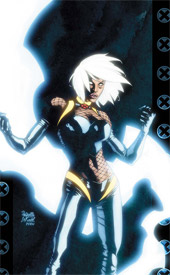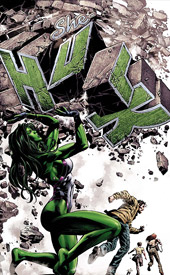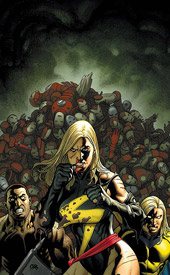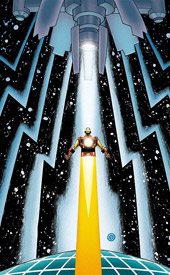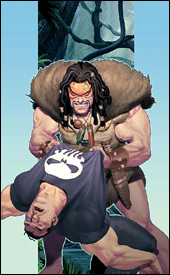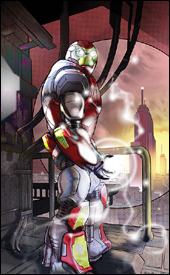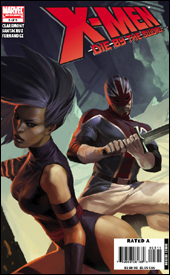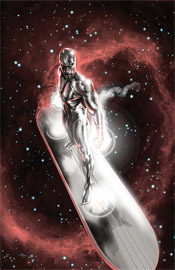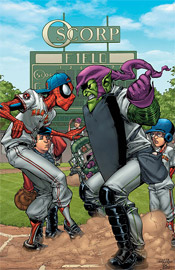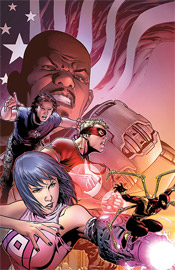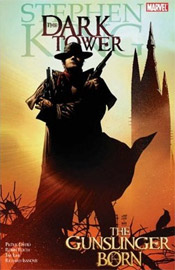The Dark Tower: The Gunslinger Born was something of a big deal for Marvel. By landing the rights to an adaptation of what Stephen King calls his “magnum opus,” the publisher had something that would attract fans that wouldn’t normally give a comic book the light of day. They pulled out the big guns: big name writer Peter David would handle the script with aid from Robin Furth, (the official
Dark Tower historian) and fan-favorite artist Jae Lee was in charge of the visuals.
As the introductory chapter of what I can only assume will eventually turn into a progression of mini-series, this should have been the writers’ chance to introduce new readers to what is obviously a very deep, well-developed mythos. Instead, I felt immediately handicapped by my lack of previous knowledge within this world. Maybe a longtime
Dark Tower devotee could jump into this series and immediately find their bearings, but new visitors are left to their own devices if they want to understand what the narrator is talking about half the time. The series has a distinct flavor, a recognizable personality that helps it to stand apart from its peers, but that’s about where the positive traits end.
One of my first problems with this story is with the characters themselves: none seem to move about with any sort of individuality or emotion. They float through life without thought. They commit to long, painful diatribes without a moment’s notice. Just as they appear to be developing some sort of personality, something to differentiate them from the grimacing masses, they spit out a paragraph of dialog so stale, it may as well have been recited directly from an encyclopedia. It’s a momentum halt, characters will so frequently jump into a random, lengthy rant. When the plot is trying to take its first twists and turns, beginning to gain some steam, it’s almost instantly stopped dead in its tracks by a dull, clichéd introduction to the story’s villains. They share two pages of back-and-forth conversation that may as well have been twenty, the panels are stuffed so full of text.
There’s also an excessive amount of narration, and none of it is even remotely easy to read. It gets so caught up in its desire to use big words and speak with an old-timey style that it nearly abandons any sense of coherence or legibility. It’s layer upon layer of foreshadowing, to the point that I often caught myself wondering if it was ever planning to pay off on the heap of promises it had already made. As I said, I’ve never read the source material, so I’m not sure if this was an effort to retain some ties to the original novels or a new innovation on the part of Furth and David. Either way, it seems out of place within this medium. Where novels can generally feel free to describe the events in great detail, comics should be able to rely much more frequently on the accompanying artwork.
That narrative is so painfully verbose that even the good moments are overpowered by the bad. When it’s at its best, this inner monologue can be quite good. It goes to great lengths to describe some of the senses that
can’t be portrayed in a visual medium – the smells and sounds of this new world, the feel of a gun that’s slid into its owner’s palm – and it’s largely successful in those instances. When the story cites the smell of grass, the promise of rain, it only serves to pull the reader into the proceedings. When it betrays the untouchable love a gunslinger holds for his weapon, it heightens the importance of the moment he actually uses it. But these triumphs are constantly overwhelmed by the tragedies of a murky choice in words and too much language in too small a space. The onslaught of vocabulary lightens up a bit as the conclusion nears, allowing the artwork to tell the story without such repeated interruptions by prose, but by then much of the damage has already been done.
That’s a shame, too, because the basic plotline has some very bright moments. The lead character’s progression from an immature, trigger-happy youth to a strategic-minded, intelligent young man is a great basic outline, even if he isn’t really likeable enough to justify the attention. His guardedly secret role as a gunslinger never realizes its potential, since every character that matters figures it all out within moments of their first meeting. His relationship with his comrades, themselves a pair of outcasts, shows flashes of potential, before being ultimately smothered by a slow pace and a sore lack of real character development. The villains are largely rooted in reality and genuinely draw the reader’s ire, but there are so damn many of them sharing the same voice, the same personality, that it’s almost impossible to tell them apart.
Jae Lee’s artwork has changed shape and style half a dozen times over the years, progressing from his ink splattered work on
Namor and the
WildC.A.T.s Trilogy to the blockier, shadow-reliant style evidenced in
The Inhumans and his creator-owned
Hellshock. But while his stuff may have taken on many different appearances, tested the waters of a broad array of stylistic pools, the one thing that’s remained consistent through it all is its beauty. So it should carry some weight when I say
The Gunslinger Born is his strongest, most consistent work to date. This is genuinely beautiful from cover to cover, without an average page of artwork in the collection.
Lee brings in bits and pieces of his past at just the right moments throughout this paperback, accompanied by a newfound attention to detail. While his compositions have always been striking, I’ve never seen them complimented by this great a level of complexity. He makes a bold statement right from the very outset, rendering a pair of buzzards at work on a deserted carcass – he’s never been so literal, so rich and developed. When an eagle’s claw tears into the soft flesh below an old man’s eyebrow, the illustration is so vivid, I swear I can hear the sound of skin tearing apart. I couldn’t dwell on the panel for long, but at the same time I didn’t want to look away… it was at once so gorgeous and so painful. Lee is still at his best when he deals with the horrific and the absurd, but that’s not his only focus. When the smooth skin of a young girl’s cheek shares a panel with the wrinkled hand of an old maid, the contrast in textures is stunning. It’s clear that he really took his time with this series, and at the end of his career, it should stand as a proud example of an ultimately realized potential.
As with any artist, Jae Lee’s work is heavily reliant on the colors that envelop it. When he was working on the second series of
Hellshock, which I still count among my favorite books, his art had never been so utterly breathtaking… something for which I’ll credit colorist Jose Villarubia. Lee’s efforts were certainly above and beyond anything he’d offered at the time, but Villarubia’s colors took them to the next level and beyond. In
The Dark Tower, Lee is paired with colorist Richard Isanove and the two make such a great pairing that I’d put them on the same level as that visual collaboration on
Hellshock.
Isanove seems to know exactly when and where to show restraint, and when to bear the full force of his talents within a panel. Even when subdued, his colors are dazzling – his ability to translate the harsh glares and rays of light that fill Lee’s work into a soft, beautiful series of lighting effects is utterly phenomenal. While the colorist does bring his own particular style to the book, (it’s immediately evident that Isanove was also responsible for coloring Adam Kubert’s work on
Origin) that never seems to get in the way or distract from Jae Lee’s efforts. If anything, it’s a perfect example of two distinct styles coming together and collaborating to create something that’s more beautiful than either could have delivered on their own.
Have you ever been reading a comic and suddenly realized that the story would work just as well, if not better, without words? That you’re only reading the captions because they’re there, not because they add anything to the proceedings? That’s
The Gunslinger Born in a nutshell. The artwork from front to rear cover is downright awesome. Jae Lee’s finally managed to top what he did in the late ‘90s on
Hellshock, and Richard Isanove makes a compelling case for himself as one of the industry’s premiere colorists. Their efforts are iconic when they need to be, gorgeously simplified when they don’t. Unfortunately the writing doesn’t even come close to the high level set by the artwork, and only really exists to entertain itself and spin its wheels. As far as introductions go, this is very long-winded and difficult to get into, although the payoff when it finally does shift gears is a good one. I guess what it comes down to, really, is where your priorities lay in a comic. If you can excuse bad writing in exchange for phenomenal artwork, you need to head out to the stores and pick this up today. If you want a little character to go along with your visuals,
you’ll be disappointed.
On a scale of 1 to 10, where 1 is poor and 10 is amazing...
Overall Score: 6.5
